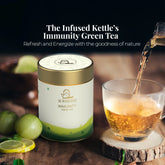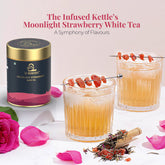The Delicate Elegance of White Tea: A Comprehensive Guide
Introduction
Tea has been cherished for centuries, with various types offering unique flavors and health benefits. Among the many varieties, white tea stands out for its delicate taste and numerous health advantages. In this blog, we'll explore what white tea is, its origins, types, uses, benefits, and tips on buying, storing, and preparing this exquisite beverage. We'll also introduce a special white tea variant available online: Moonlight Strawberry White Tea from The Infused Kettle.
What is White Tea?
White tea is one of the least processed types of tea, known for its subtle flavor and gentle aroma. Unlike other teas, white tea undergoes minimal oxidation, preserving more of its natural nutrients. The leaves are harvested before they fully open, while the young buds are still covered in fine white hairs, hence the name white tea.
What’s Oxidation Got to Do with It?
Oxidation is a key factor that distinguishes different types of tea. It’s the process where tea leaves are exposed to oxygen, affecting their chemical composition and flavor. For example, black tea is fully oxidized, while green tea is not oxidized at all. White tea, on the other hand, is only slightly oxidized, retaining its delicate and fresh characteristics. This minimal processing helps preserve more of the antioxidants and beneficial compounds present in the tea leaves.
White Tea Origins
White tea has its roots in the Fujian province of China, where it has been cultivated for centuries. Historically, it was a luxury reserved for royalty due to its intricate production process and limited availability. Today, while it’s more accessible, authentic white tea from China remains highly prized. Other regions, including India and Sri Lanka, have also started producing high-quality white teas, each with its unique flavor profile.
Types of White Tea
White tea comes in various types, each with distinct characteristics. The main types include:
- Silver Needle (Bai Hao Yin Zhen): This is the most premium type, made exclusively from the young, unopened buds covered in white hairs. It has a delicate, sweet flavor and a light, pale color.
- White Peony (Bai Mu Dan): Made from both buds and leaves, White Peony offers a fuller flavor compared to Silver Needle. It has a slightly stronger taste with floral and fruity notes.
- Long Life Eyebrow (Shou Mei): This variety is made from older leaves and is more oxidized than other white teas, giving it a darker color and a richer, more robust flavor.
- Tribute Eyebrow (Gong Mei): Similar to Shou Mei, but considered a higher grade. It has a more complex flavor profile, often with hints of honey and fruit.
White Tea Uses
White tea is not just for sipping. Its subtle flavor and health benefits make it a versatile ingredient in various applications, including:
- Beverages: Enjoy it hot or cold, plain or blended with other flavors.
- Cooking: Use white tea as a base for soups, sauces, and marinades.
- Skincare: Its antioxidant properties make it a popular ingredient in skincare products.
- Baking: Infuse cakes, cookies, and pastries with white tea for a unique twist.
10 Impressive Benefits of White Tea
White tea is renowned for its numerous health benefits. Here are ten impressive reasons to include it in your daily routine:
- Rich in Antioxidants: White tea contains high levels of polyphenols, which help fight free radicals and reduce oxidative stress.
- Promotes Heart Health: Regular consumption can help lower blood pressure and cholesterol levels, reducing the risk of heart disease.
- Supports Weight Loss: White tea can boost metabolism and aid in fat burning, making it a great addition to a weight loss regimen.
- Improves Skin Health: Its antioxidant properties help protect the skin from damage and reduce signs of aging.
- Boosts Immunity: The catechins in white tea can enhance the immune system's ability to fight infections.
- Reduces Inflammation: White tea has anti-inflammatory properties that can help alleviate conditions like arthritis.
- Enhances Oral Health: It contains fluoride, tannins, and catechins that can strengthen teeth and prevent cavities.
- Supports Mental Health: Regular consumption of white tea can help reduce stress and improve mental clarity.
- Regulates Blood Sugar: White tea can help manage blood sugar levels, making it beneficial for people with diabetes.
- Promotes Digestive Health: It aids in digestion and can help soothe gastrointestinal issues.
Buying and Storing White Tea
When buying white tea, quality is key. Look for reputable sellers who offer fresh, high-grade tea. Loose-leaf white tea is generally of higher quality than tea bags.
To store white tea, keep it in an airtight container away from light, heat, and moisture. This will help preserve its delicate flavor and beneficial properties. Avoid storing it in the refrigerator, as the moisture can degrade the tea.
Preparing White Tea
Preparing white tea is a simple process, but it requires attention to detail to get the best flavor. Here’s how to do it:
- Water Temperature: Use water that is not boiling but just below, around 170-185°F (75-85°C). Boiling water can scorch the delicate leaves.
- Tea Quantity: Use about 2 grams of tea per 8 ounces of water. Adjust according to your taste preference.
- Steeping Time: Steep the tea for 3-5 minutes. Too long, and it can become bitter; too short, and it may be too weak.
- Multiple Infusions: High-quality white tea can be steeped multiple times. Each infusion will reveal different nuances in flavor.
How to Drink White Tea
Drinking white tea is a delightful experience. Here are some tips to enhance your enjoyment:
- Plain: White tea is best enjoyed plain, without milk or sugar, to appreciate its subtle flavor.
- Iced: Brew it stronger than usual, then chill and serve over ice for a refreshing summer drink.
- Flavored: Add a slice of lemon, a sprig of mint, or a few berries to complement the tea’s natural sweetness.
- Blended: Mix white tea with other teas or herbal infusions to create unique blends.
Buy Moonlight Strawberry White Tea Online at The Infused Kettle
For a unique twist on traditional white tea, try Moonlight Strawberry White Tea from The Infused Kettle. This exquisite blend combines the delicate flavor of white tea with the sweet, fruity notes of strawberries, creating a delightful and refreshing beverage. You can purchase it online, ensuring you get a high-quality product delivered right to your door.
Conclusion
White tea is a remarkable beverage, offering a perfect blend of delicate flavor and impressive health benefits. Its minimal processing preserves its natural goodness, making it a valuable addition to any tea lover’s collection. Whether you enjoy it plain, iced, or blended, white tea is a versatile and delightful drink that can enhance your overall well-being. Remember to choose high-quality tea, store it properly, and follow the correct preparation methods to enjoy the best possible experience. And for a special treat, don’t forget to try Moonlight Strawberry White Tea from The Infused Kettle. Enjoy the serene and subtle elegance of white tea in every sip!
Related Posts:
Discover the World of Black Tea with The Infused Kettle
Roasted Chocolate Black Tea: Meaning, Benefits and Side Effects
The Infused Kettle's Apple Cinnamon Tea: A Symphony of Flavor and Wellness
Cutting Chai : Why Mumbai Loves Half Cutting Chai?
FAQ's
Q. What is white tea made of?
Ans: White tea is made from the young leaves and unopened buds of the Camellia sinensis plant. These are minimally processed, preserving their natural compounds and delicate flavor.
Q. What is another name for white tea?
Ans: White tea is also known as Bai Cha in Chinese. Specific varieties have unique names, such as Bai Hao Yin Zhen Silver Needle and Bai Mu Dan White Peony.
Q. What does white tea taste like?
Ans: White tea has a light, delicate, and slightly sweet flavor with floral or fruity notes. It is smooth and lacks the bitterness found in other teas, offering a gentle and refreshing taste.
Q. Is white tea expensive?
Ans: White tea can be more expensive than other teas due to its labor-intensive harvesting and limited production. Premium varieties like Silver Needle are particularly costly, but more affordable options like White Peony are available.
Q. How to make white tea at home?
Ans:
- Measure the Tea: Use 2 grams of loose-leaf white tea per 8 ounces of water.
- Heat the Water: Heat water to 170-185°F (75-85°C), not boiling.
- Steep the Tea: Pour hot water over the tea leaves and steep for 3-5 minutes.
- Strain and Serve: Strain the leaves and enjoy the tea plain or with a slice of lemon or mint.
- Multiple Infusions: High-quality white tea can be steeped multiple times.
With these simple steps, you can enjoy a perfect cup of white tea at home, savoring its subtle and refreshing flavor.







